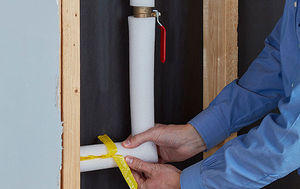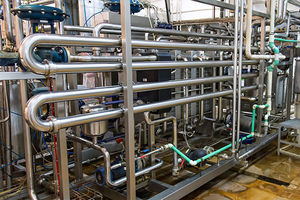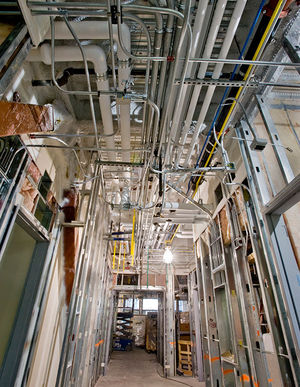WHAT IS PLUMBING?
 Plumbing is defined as the system of pipes, tanks, and fittings required for the water supply, heating, and sanitation in a building. Essentially plumbing allows water into a building and provides safe drainage for water and wastewater as it exits a building through a predefined network of pipework. To be installed and maintained, all plumbing systems require permits, inspections, and adherence to building codes, regulations, and industry standards. These strict regulations narrow material options for plumbing systems, so pipes will typically be made of copper or plastic. The most common uses for plumbing include distributing potable water (hot and cold), waste removal, and heating/cooling systems.
Plumbing is defined as the system of pipes, tanks, and fittings required for the water supply, heating, and sanitation in a building. Essentially plumbing allows water into a building and provides safe drainage for water and wastewater as it exits a building through a predefined network of pipework. To be installed and maintained, all plumbing systems require permits, inspections, and adherence to building codes, regulations, and industry standards. These strict regulations narrow material options for plumbing systems, so pipes will typically be made of copper or plastic. The most common uses for plumbing include distributing potable water (hot and cold), waste removal, and heating/cooling systems.
WHAT IS PROCESS PIPING?
 Process piping at first glance might seem like any other plumbing systems, and while there are physical similarities, they serve very different functions. Process piping distributes or converts chemicals, gases, water, and other fluids in support of a manufacturing or processing operation usually associated with industrial factories and manufacturing facilities. Process piping is more complicated as it contains interconnected components including separators, flanges, pressure hoses, traps, valves, strainers, gaskets, temperature controls, and more. Process piping systems are excluded from a building’s mechanical systems, so they aren’t ruled by building codes. Instead process piping systems must meet engineering standards that usually fall under the American Society of Civil and Mechanical Engineers (ASCME) guidelines. These systems must also adhere to OSHA standards for safe operation and some process piping systems may require initial permitting, inspection, and approval. Process piping also uses a broader selection of pipe materials based on use, budget, and the type of fluids being moved. Process piping systems support a variety of industrial or manufacturing functions like mixing, separating, stopping liquid flow, cooling, pressurization, filtering, and refining.
Process piping at first glance might seem like any other plumbing systems, and while there are physical similarities, they serve very different functions. Process piping distributes or converts chemicals, gases, water, and other fluids in support of a manufacturing or processing operation usually associated with industrial factories and manufacturing facilities. Process piping is more complicated as it contains interconnected components including separators, flanges, pressure hoses, traps, valves, strainers, gaskets, temperature controls, and more. Process piping systems are excluded from a building’s mechanical systems, so they aren’t ruled by building codes. Instead process piping systems must meet engineering standards that usually fall under the American Society of Civil and Mechanical Engineers (ASCME) guidelines. These systems must also adhere to OSHA standards for safe operation and some process piping systems may require initial permitting, inspection, and approval. Process piping also uses a broader selection of pipe materials based on use, budget, and the type of fluids being moved. Process piping systems support a variety of industrial or manufacturing functions like mixing, separating, stopping liquid flow, cooling, pressurization, filtering, and refining.
WHAT MAKES PROCESS PIPING DIFFERENT FROM PLUMBING?
While process piping and plumbing share many similarities, the ultimate difference lies within the purpose of the piping system and its connection. Another important difference to note is the requirement to comply with building codes vs engineering guidelines and standards.
DO PLUMBING AND PROCESS PIPING SYSTEMS NEED INSULATION?
 A resounding yes! Both plumbing and process piping systems can benefit from being properly insulated. Flexible elastomeric closed-cell insulation products like Armacell’s ArmaFlex®, Tubolit®, Imcoa® and Tundra® are energy efficient insulation options for plumbing and process piping systems. Closed-cell foam products maintain their physical and thermal integrity for the life of the mechanical system and are efficient thermal barriers that provide energy efficiency for piping, tanks, and related mechanical systems. The low thermal conductivity of closed-cell foam insulation provides energy efficiency to maintain temperature and low water-vapor transmission properties reduce the need for additional vapor retarders. This moisture-resistant characteristic makes ArmaFlex, Tubolit, Imcoa, and Tundra especially valuable on chilled-water piping where condensation might otherwise soak through fibrous types of insulations, significantly degrading their thermal performance, leaving them susceptible to fungal growth, and ultimately shortening their lifecycle.
A resounding yes! Both plumbing and process piping systems can benefit from being properly insulated. Flexible elastomeric closed-cell insulation products like Armacell’s ArmaFlex®, Tubolit®, Imcoa® and Tundra® are energy efficient insulation options for plumbing and process piping systems. Closed-cell foam products maintain their physical and thermal integrity for the life of the mechanical system and are efficient thermal barriers that provide energy efficiency for piping, tanks, and related mechanical systems. The low thermal conductivity of closed-cell foam insulation provides energy efficiency to maintain temperature and low water-vapor transmission properties reduce the need for additional vapor retarders. This moisture-resistant characteristic makes ArmaFlex, Tubolit, Imcoa, and Tundra especially valuable on chilled-water piping where condensation might otherwise soak through fibrous types of insulations, significantly degrading their thermal performance, leaving them susceptible to fungal growth, and ultimately shortening their lifecycle.
- Ensures long-term thermal performance
- Inhibits mold and mildew, protects IAQ, MICROBAN anti-microbial additive.
- Withstands punctures while protecting pipe systems
- Moisture won’t wick, no additional vapor retarder required
- Acceptable for chilled pipes and for use on heat tracing piping up to 180 °F
